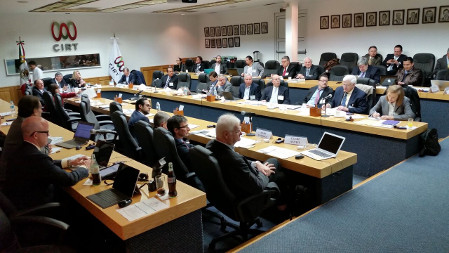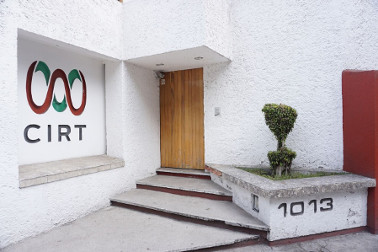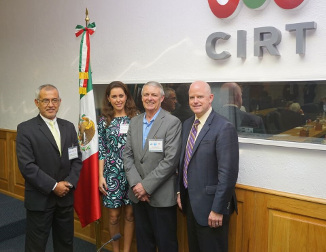NABA Meeting Highlights Changing Landscape
The author is director-general of the North American Broadcasters Association. Commentaries from NABA are a recurring feature on radioworld.com.
MEXICO CITY—The North American Broadcasters Association held its Annual General Meeting in Mexico City, March 1–3. Our Mexican members Televisa and TV Azteca hosted the three-day event at the facilities of Cámara Nacional de la Industria de Radio y Televisión (CIRT).
It was an important occasion since NABA had not held an AGM in Mexico in more than a decade. It provided a most productive exchange of ideas, information, new technologies and business plans between broadcasters in Mexico, the United States and Canada all in the context of a rapidly changing broadcast landscape in Mexico.

Televisa and TV Azteca hosted the three-day event at the facilities of Cámara Nacional de la Industria de Radio y Televisión (CIRT). Photos courtesy David Layer.
On March 1, NABA had a full day of committee and board meetings dealing with work on the next generation of television, protection from piracy of broadcast signals and our agenda for the year ahead. This includes ATSC 3.0 implementation, media over IP, a common metadata chip in file formats, High Dynamic Range (HDR), cybersecurity, a renewed effort on achieving a broadcaster treaty at the World Intellectual Property Organization (WIPO) to protect broadcast signals, and continued work on understanding how the broadcast business model is changing in an IP and OTT (Over-the-Top) world.
It was a most productive day, which ended with a dinner hosted by TV Azteca for all the AGM delegates where Benjamin Salinas, the newly appointed CEO of Azteca, welcomed everyone to Mexico City and talked about the need for easing some of the regulatory framework such as imposing hourly public service advertising on Mexican broadcast networks.
The next day was full with panels and keynote remarks where our Mexican colleagues picked up on the theme introduced by Benjamin Salinas the night before. Sergio Sarmiento, a NABA board member and newly elected NABA VP who is editor-in-chief for TV Azteca, talked about the deterioration of the business environment for broadcast networks and the onerous impact of hourly public service messages (three minutes an hour) that amount to nothing less than government/political propaganda that drives both audiences and advertisers away. This obligation for broadcast networks does not apply to cable or satellite services and thus unfairly impacts them in a very competitive environment.
Edgar Pereda, the president of CIRT, also called for regulatory officials to better understand the challenges of the broadcast environment, and reinforced the theme introduced by Sarmiento. He suggested officials should consult more widely and work with the broadcast community to have a regulatory framework that is fair for everyone and reflects the realities of the industry.
Both of the Mexican keynotes gave the rest of the AGM delegates from North America real insight into the current challenges for broadcast television in Mexico.

There were two very good panels on the next generation of television. The first was moderated by Glenn Reitmeier, Senior VP, technology standards, NBCU and former ATSC chairman, who gave a very good overview of ATSC 3.0. Panelists from the three NABA territories joined him as they discussed the features the new technology could give them to make their broadcast operations more efficient and flexible.
The next panel stayed with the “next generation” theme and focused on deployment strategies for the new broadcast technologies. John Lee, executive director, technology solutions, CBC/Radio Canada (and chair of the NABA Technical Committee) lead the panel. Colleagues with special knowledge of the legal, spectrum, operational and business issues from the U.S. joined him to explore how best the industry can migrate to the next generation. Everyone in the room knew that a successful migration in the US would lead to successful ones in Canada and Mexico, and indeed in other countries in the Americas and Asia.
Other AGM speakers included Jeff Smulyan, CEO of Emmis Communications, who talked about the next generation of radio; the importance of FM chips in mobile phones; apps that give listeners more interaction with broadcast services; and the rollout of digital radio. An important contribution in a day dominated by television content. And we also heard from Fred Mattocks, head, technical strategy for CBC/Radio-Canada about how important getting the strategy and tactics right is for our business since the challenges realizing the next generation are formidable for us all.
While I don’t have the space to give you all the content, it was a very good day that ended with our formal AGM where Bob Ross, senior VP, east coast operations CBS, stepped down as NABA president (he will remain as a board member) and the newly elected executive was introduced. They are NABA President Richard Friedel (executive VP, engineering & operations, Fox Networks and ATSC chairman), NABA Vice-President Sergio Sarmiento (editor-in-chief, TV Azteca), and NABA Vice-President (reelected) John Lee (executive director, technology solutions CBC/Radio-Canada). I thank Bob Ross for his service and leadership to NABA over the past years and look forward to the leadership of the new Executive over their two-year term.
On March 3 we held the “Future of Radio & Audio Symposium.” Paul Brenner, senior VP, Emmis Communications and vice-chair of NABA’s Radio Committee, chaired the day. It was the second Radio Symposium that NABA has done; the first was held in Toronto last year, a third will be held in Washington next year.
It was another day packed with great information, with speakers and panelists interacting with the attendees. The director-general of CIRT gave the opening keynote and, like his counterparts from television the day before, he focused on the new communications law, reform of the electoral law and technological delay. This was an informative context for all the symposium delegates on the challenges facing Mexican radio broadcasters as they embrace change, and it provided a background for the discussions and presentation that followed

Participants in the panel “North American Update on the FM Chip in Mobile Devices.” From left: Daniel Chappell, director, Comite de Radio, PI-AR; Mariana Ferreira, senior director, business development, BLU Products Inc.; Kirk Nesbitt, technical advisor, Canadian Association of Broadcasters; and Sam Matheny, CTO and executive vice-president, National Association of Broadcasters (U.S.)
We also had a panel and then a presentation on the rollout of HD Radio in Mexico. The panel was chaired by Claudio Martinez (VP, consumer electronics business development, DTS Inc.) and included a number of Mexican broadcasters who discussed both business and operational issues. Glynn Walden, whom many consider to be the “father” of HD Radio, participated and added great value to the discussion. At the end of the panel we had a presentation from Miguel Fernandez Arias, director, engineering, IMER (Instituto Mexicano de la Radio) on the technical issues surrounding the rollout of HD Radio in Mexico City.
John Ellis (founder & managing director, Ellis & Associates) gave a terrific presentation on the connected car, covering both the challenges and opportunities open to broadcasters. It is clear that the car is key to a radio broadcaster’s business plan; to not be a part of that connected world is to not have a business. It was great no-nonsense advice from John.
The symposium ended with a great panel chaired by David Layer (senior director, advanced engineering, NAB and Chair, NABA-RC FM Chip WG) focusing on getting the FM chip turned on in mobile phones. Colleagues from Canada, Mexico and the U.S. joined him, and while great strides have been made in the U.S. to get the carriers to activate the chip, there has been little success in Canada and Mexico. Like the connected car, getting the Chip turned on, with the appropriate app to maximize the benefit, is critical to the medium’s future.
Paul Brenner wrapped up the symposium and noted how pleased NABA was about being in Mexico and understanding the Mexican perspective on the challenges we all face.
Paul’s right, it was a great three days. Our thanks to our Mexican hosts: Televisa, TV Azteca and CIRT.
Get the TV Tech Newsletter
The professional video industry's #1 source for news, trends and product and tech information. Sign up below.
